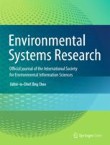Urban flood susceptibility evaluation and prediction during 2010–2030 in the southern watersheds of Mashhad city, Iran
Urban flood susceptibility evaluation (FSE) can utilize empirical and rational procedures to focus on the urban flood evaluation using physical coefficients and land-use change ratios. The main aim of the pres...

